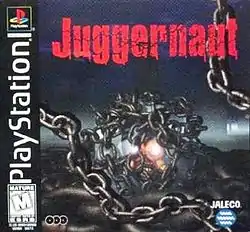Juggernaut (video game)
Juggernaut, known in Japan as Juggernaut: Senritsu no Tobira (ジャガーノート 戦慄の扉, , lit. Juggernaut: Terrifying Door), is a horror-themed adventure game published by Jaleco in 1999 for the PlayStation. It was developed by the Japanese studios Will and Tonkin House. The game play is similar to that of the popular adventure game Myst and featured FMV sequences.
| Juggernaut | |
|---|---|
 | |
| Developer(s) | Will/Tokin House |
| Publisher(s) | Jaleco |
| Platform(s) | PlayStation |
| Release | |
| Genre(s) | Adventure |
| Mode(s) | Single-player |
Plot
The player controls an unnamed young man whose girlfriend, Sarah, has been possessed by demonic forces. A priest appears to instruct him on how to save her soul. After shedding his mortal body the man enters Sarah's mind, which has taken the shape of a large mansion. He must then collect items, solve puzzles, and utilize different bodies provided in the mansion to unlock the microcosm hub. This leads to other parts of Sarah's soul that must be cleansed. As he nears the final confrontation with the devil, he quickly discovers that there are other, more pressing mysteries about his encounter that need to be solved.
Gameplay
Juggernaut is a first person game that focuses on item collection and puzzle solving. The player can only move along set paths with the compass on the bottom of the screen and interact with objects using the research cursor, which spins when an item can be used. While in the mansion, the player must also utilize several different bodily forms to access all available areas. Machines called ’soul exchangers’ will transfer the player's spirit into either a Juvenile body, which is used to open small doors, or an Adult Body, which is used to open large doors and interact with most objects. While in the soul form, the player can fit through small holes in the mansion but cannot pick up items or open doors.
While the focus is on solving puzzles and riddles, several scenarios occur in which the player must use weapons or dodge attacks within a set time frame. If the player fails to complete the event, he is either sent back to the point right beforehand or sent back to the beginning to complete the scenario again.
There are four microcosm hubs to explore, each with two scenarios to complete. The scenarios are set in either a prison island, a jungle, a forest or cyberspace, and all spread across three discs. Although each hub requires a different disc to play, the order has no effect on the overall game play, giving it a bit of an open world feel.
Reception
Adam Pavlacka reviewed the PlayStation version of the game for Next Generation, rating it three stars out of five, and stated that "Juggernaut isn't anything new or especially exciting, just a solid entry in the point-and-click genre, with a better puzzle selection and more intriguing story than most."[1]
The game was poorly received due in part to the visuals and lackluster story.[2][3] However the music and sound effects were praised by fans and critics of the game.[2] It currently holds a rating of 4.4 on GameSpot.com.[3]
References
- Pavlacka, Adam (November 1999). "Finals". Next Generation. Vol. 2 no. 3. Imagine Media. p. 119.
- Bishop, Sam (January 7, 2000). "Juggernaut". IGN. Ziff Davis. Retrieved December 5, 2019.
- Taruc, Nelson (May 2, 2000). "Juggernaut Review". GameSpot. CBS Interactive. Retrieved December 5, 2019.
